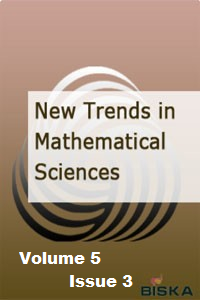Research Article
Year 2017,
Volume: 5 Issue: 3, 85 - 96, 01.07.2017
Abstract
References
- B. Charlesworth, Evolution in age-structured populations, Cambridge University Press, Cambridge, 1980.
- J. A. J. Metz and O. Diekmann, The dynamics of physiologically structured populations, Lect. Notes in Biomathematics, 68, Springer, Berlin-Heidelberg-New York, 1986.
- J. M. Cushing, An introduction to structured population dynamics, SIAM, Philadelphia, 1998.
- J. D. Murray, Mathematical biology I. An introduction, 3 rd ed., Springer, New York, 2002.
- J. M. Cushing and M. Saleem, A predator prey model with age structure, J. Math. Biology, 14 (1982), 231-250.
- M. E. Gurtin and D. S. Levine, On predator-prey interactions with predation dependent on age of prey, Math. Biosciences, 47(3-4)(1979), 207-219.
- M. Saleem, Predator-prey relationships: egg-eating predators, Math. Biosciences, 65(2) (1983), 187-197.
- M. Saleem, Egg-eating age-structured predators in interaction with age-structured prey, Math. Biosciences, 70(1) (1984), 91-104.
- M. Saleem, S. U. Siddiqui, and V. Gupta, A mathematical model with young predation, J. of Math. Biology, 25(1) (1987), 89-101.
- M. Saleem and R. K. Pandey, Egg-eating age-structured predator and prey interactions: some simple cases, Math. Biosciences, 89(2) (1988), 209-224.
- J. D. Logan, An introduction to nonlinear partial differential equations, Wiley Interscience, New York, 2008.
- F. Brauer and C. Castillo-Chavez, Mathematical models in population biology and epidemiology, Springer, New York-Dordrecht-Heidelberg-London, 2012.
- G. Leoni, A first course in Sobolev spaces, AMS, Providence, 2009.
Year 2017,
Volume: 5 Issue: 3, 85 - 96, 01.07.2017
Abstract
We investigate a predator-prey model for egg-eating predators in which the prey population is assumed to have an age structure. By the method of characteristics, this model reduces to a system of integral equations. Then a generalization of the Banach fixed-point theorem is used to show, under relatively mild conditions, the existence of a unique, global, weak solution to the population problem. Furthermore, this methodology allows us to generate a sequence of iterates, called the Picard iterates, that converges to the solution. Also, we strengthen the assumptions of the existence-uniqueness theorem to establish the validity of the corresponding conservation law in integral form. Thus we prove a result which shows the coexistence of both predator and prey species over a long time.
References
- B. Charlesworth, Evolution in age-structured populations, Cambridge University Press, Cambridge, 1980.
- J. A. J. Metz and O. Diekmann, The dynamics of physiologically structured populations, Lect. Notes in Biomathematics, 68, Springer, Berlin-Heidelberg-New York, 1986.
- J. M. Cushing, An introduction to structured population dynamics, SIAM, Philadelphia, 1998.
- J. D. Murray, Mathematical biology I. An introduction, 3 rd ed., Springer, New York, 2002.
- J. M. Cushing and M. Saleem, A predator prey model with age structure, J. Math. Biology, 14 (1982), 231-250.
- M. E. Gurtin and D. S. Levine, On predator-prey interactions with predation dependent on age of prey, Math. Biosciences, 47(3-4)(1979), 207-219.
- M. Saleem, Predator-prey relationships: egg-eating predators, Math. Biosciences, 65(2) (1983), 187-197.
- M. Saleem, Egg-eating age-structured predators in interaction with age-structured prey, Math. Biosciences, 70(1) (1984), 91-104.
- M. Saleem, S. U. Siddiqui, and V. Gupta, A mathematical model with young predation, J. of Math. Biology, 25(1) (1987), 89-101.
- M. Saleem and R. K. Pandey, Egg-eating age-structured predator and prey interactions: some simple cases, Math. Biosciences, 89(2) (1988), 209-224.
- J. D. Logan, An introduction to nonlinear partial differential equations, Wiley Interscience, New York, 2008.
- F. Brauer and C. Castillo-Chavez, Mathematical models in population biology and epidemiology, Springer, New York-Dordrecht-Heidelberg-London, 2012.
- G. Leoni, A first course in Sobolev spaces, AMS, Providence, 2009.
There are 13 citations in total.
Details
| Primary Language | English |
|---|---|
| Subjects | Mathematical Sciences, Applied Mathematics |
| Journal Section | Articles |
| Authors | |
| Publication Date | July 1, 2017 |
| Published in Issue | Year 2017 Volume: 5 Issue: 3 |


